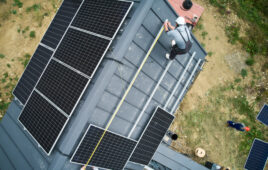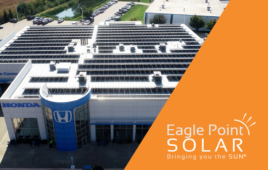
Background
Wind exposure category is a critical input parameter for structural designs including commercial rooftop PV systems. Most typical building sites fall into category B (urban, suburban, wooded) or C (Open terrain with scattered obstructions). Category D sites (flat, unobstructed areas) are less common.
Wind exposure category affects wind pressures on a structure significantly. Therefore, applying the appropriate value for a given site is critical. Using the wrong setting can result in structural failure or overdesign. Arguably, the former is worse than the latter, but most stakeholders do not want to overspend needlessly.
The main definitions for exposure categories in ASCE 7 are very simple and do not explore how to determine and account for large or small transitions in exposure. For instance, it is common to require an understanding of the effect of large openings in an otherwise typical Exposure B. The ASCE 7 commentary includes guidance to determine the net effect of open patches. Code revisions prior to ASCE 7-16 included such commentary which left quite a bit of room for interpretation. In the 7-16 and 7-22 revisions, used by most US AHJ’s today, the commentary is more formulaic thus eliminating most ambiguities of previous revisions.
Determining Exposure Category
For some project sites, determination of the correct wind exposure is straightforward. As an example, the building site highlighted below[1] is obviously located in an urban area and the surrounding area is consistent with surface roughness B conditions[2] for over 1500 ft. in all upwind directions.

For this project, the total wind uplift force on the PV system came to approximately 90,000 lbs. It’s interesting to note that switching to exposure C increases the total uplift to over 126,000 lbs. (40% higher!).
Sorting out the exposure category is not always so simple although careful consideration of the code guidelines leads to the appropriate selection. In the example shown below, one might conclude that exposure B is the correct value to apply.

ASCE 7 requires evaluation of all wind directions on a sector-by-sector basis where each sector covers 45 degrees of the compass. The two sectors extending on either side of the selected wind direction are used to determine exposure for that direction, with the sector with the highest wind loads representing the controlling case. Although it is permitted to consider exposure for each wind direction, this adds a tremendous amount of complexity to projects. It is common practice and generally recommended to consider the worst-case wind exposure for the entire project. Winds approaching this site from most directions experience surface roughness B, but winds from the south and east ‘see’ roughness C. Therefore, the design must use C for the entire project.
Like the first example, applying exposure B rather than C yields a design plan with substantially less ballast. The ‘C’ design has 2400 ballast blocks and 6 roof anchors whereas using exposure B results in just 1307 ballast blocks and no anchors. This version of the design is unsafe and would likely sustain damage early in its service lifetime.
Most commercial and industrial PV project locations fall into exposure category C simply because this property type is typically found in suburban areas where the surrounding land area is at least partially clear of meaningfully sized structures. If a building’s roof height exceeds 30 ft., the site is even more likely to meet exposure C criteria because the qualifications to meet for exposure B extend up to 2,600 ft (a 73% increase). Intermediate exposure between the predefined categories may be appropriate for some sites.
PanelClaw and its structural engineering partners follow the sector analysis methodology in the commentary of recent code revisions because this approach yields safer solar designs. PV racking design differs from low-rise building design in that PV systems are aerodynamically sensitive and largely controlled by wind uplift and overturning. In other words, PV projects are inherently more susceptible to catastrophic damage from wind loads whereas under-designed building envelopes, e.g. roof membranes, typically sustain only minor damage when under-designed. Furthermore, PV structures designed utilizing the Boundary Layer Wind Tunnel (BLWT) testing inherently have smaller margins of error than those using the guidance in Chapter 29 of ASCE 7 which is conservative for most flat roof PV structures on the market.
Conclusion
Rooftop PV systems are subjected to localized wind pressures that vary significantly over the surface of a building. Structural designs must account for peak wind loads that may affect small areas of a building’s envelope to ensure components can resist wind-induced forces without failing. Ballasted flat roof PV structures are aerodynamically sensitive and failures due to uplift or sliding can be sudden and catastrophic. Use of aggressive or optimistic design criteria, including wind exposure category, can result in damage from winds well below the expected worst case conditions[3]. If PanelClaw specifies a given exposure for a project site, e.g. C, and another racking vendor suggests a different, less conservative one, e.g. B, stakeholders would be wise to question such determinations.

Racking product depicted is from a vendor that is no longer in business.
PC_WE_PV Animation from Enstall on Vimeo.
Appendix[4]
Surface roughness and Exposure Category definitions from ASCE 7-22


Sector analysis rules from ASCE 7-22 Commentary

[1] Building height = 30 ft.
[2] See appendix for details.
[3] Check out the animation here for a visual representation of what can happen.
[4] With permission from ASCE. This material may be downloaded for personal use only. Any other use requires prior permission of the American Society of Civil Engineers. This material may be found at https://doi.org/10.1061/9780784415788.
Sponsored Content by PanelClaw





Tell Us What You Think!